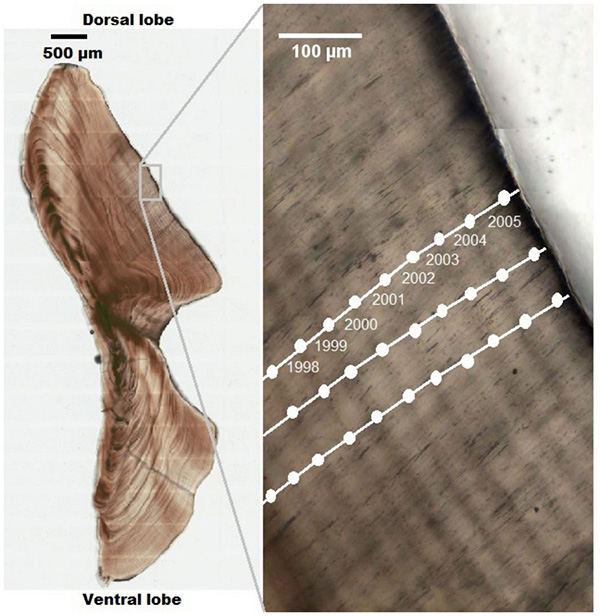
by Lucas Joel Friday, May 29, 2015
Most fish have little structures in their skulls that record growth patterns — periods of feast and famine — just like tree rings. Now, scientists are using these structures, called otoliths, to show how fish size may decrease as a result of a changing ocean.
Otoliths occur on each side of a fish’s head just behind the brain, where they help with balance and hearing. They are unique because, like a tree, they deposit seasonal growth lines throughout a fish’s life. During periods of low food availability, growth lines are thinner; when food is more plentiful, growth lines are thicker. This fact has been known for awhile, thanks to fisheries collecting and storing otoliths for well over 100 years to track fish growth. Fisheries collect otoliths because they are good records of fish size changes from year to year; they help fisheries track which years were good years in terms of fish size, and, thus, profit, and which were not.
Mark Meekan, a marine biologist at the Australian Institute of Marine Sciences, decided to see if otolith growth lines could show anything about how fish are responding to changes in the oceans as a result of climate change. In a new study in Scientific Reports, he and his colleagues looked at otoliths from a deepwater predatory fish called hapuku.
Hapuku are found off the southwestern coast of Australia in waters near an ocean current known as the Leeuwin Current. Climate change models predict that, as the ice caps melt due to global warming, more freshwater will drain into the oceans and sea levels will rise. The injection of freshwater will also make the oceans less salty, which will weaken ocean circulation, and, in turn, reduce the strengths of currents.

Otolith from a 32-year-old hapuku. Right-hand image shows growth lines by year. Credit: Mark Meekan
Ocean currents act as conveyor belts: They transport and deliver nutrients to marine ecosystems. Weaker currents mean fewer nutrients will be transported to waters where animals like hapuku reside. To assess what effects a weaker Leeuwin Current might have on hapuku, the study’s researchers looked at the fish’s otolith growth lines, and compared their fluctuating thicknesses to sea-level changes over time. Growth lines were compared to sea-level changes because sea level correlates with current strength: If sea level increases, then current strength will decrease, which, in turn, will decrease nutrient delivery. Ultimately, hapuku growth rates and size will decrease as well, Meekan says.
Meekan and his colleagues looked at hapuku aged 27 to 49 years, and they found that growth from 1990 to 2004 was positively correlated with the mean annual sea level along the southwestern Australian coast. Because “sea-level rise as a result of global warming is predicted to slow down ocean currents,” Meekan says, this will result in “fewer nutrients and, ultimately, less food for hapuku,” and the fish will get smaller.
“We have a correlation between sea level, hapuku growth lines, and, ultimately, the productivity of the Leeuwin Current,” Meekan says. “It’s a reasonably strong smoking gun, and it shows that hapuku growth integrates a lot of different things that are going on in the environment.”
Hapuku do not consume nutrients delivered by ocean currents directly. Instead, primary producers like plankton eat the nutrients, and organisms slightly higher in the food web, like squid, eat the plankton. Animals like hapuku, in turn, eat the squid.
“There are only a few steps in the food web between primary producers like plankton and hapuku,” Meekan says. “This may be part of why the correlation between nutrient availability and hapuku size is so strong, since nutrient concentrations in the ecosystem are not diluted by passing through a high number of organisms in the food web.”
Nutrient availability is not the only factor that can impact fish size, though. “Temperature changes can also affect growth rates,” says Steven Campana of the University of Iceland, an otolith expert who was not involved in the study. “However, temperatures tend to remain stable at the depths where hapuku reside — about 200 meters below the surface — so any changes in the size of otolith growth lines are almost certainly tied to changes in food consumption,” he notes.
The study is unique, Campana says, because the researchers have taken techniques typically used to study trees and successfully applied them to studying fish growth lines. “This is a very convincing correlation between hapuku growth and sea-level change,” he says.
Next, Meekan hopes to expand sampling in order to see if the hapuku discovery holds true in otoliths from other fish species. “Thanks to the fisheries keeping such good records,” he says, “otoliths are an unparalleled treasure trove of growth data.”
© 2008-2021. All rights reserved. Any copying, redistribution or retransmission of any of the contents of this service without the expressed written permission of the American Geosciences Institute is expressly prohibited. Click here for all copyright requests.